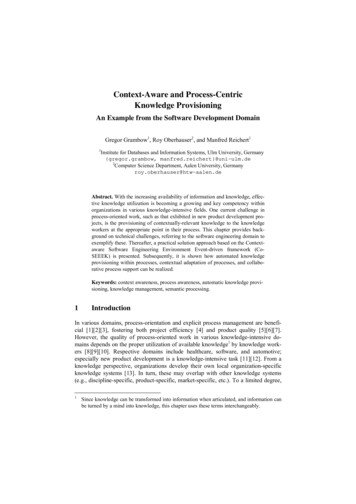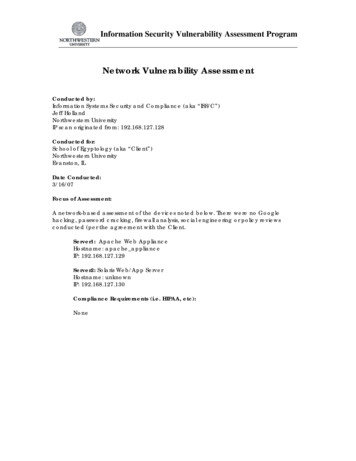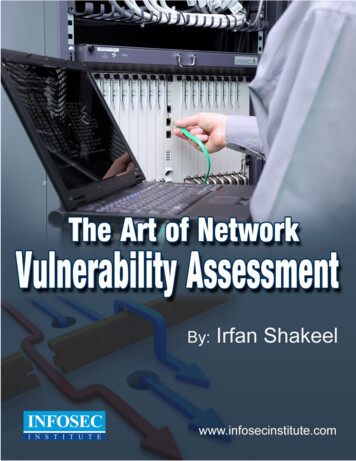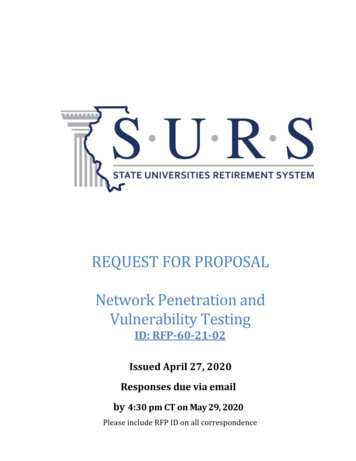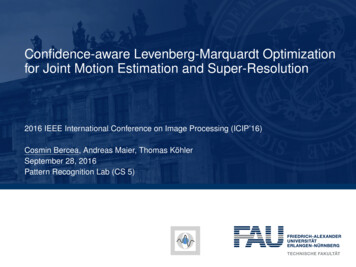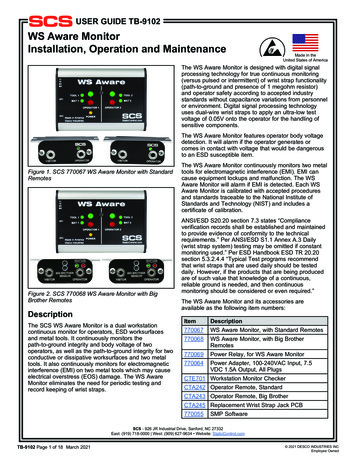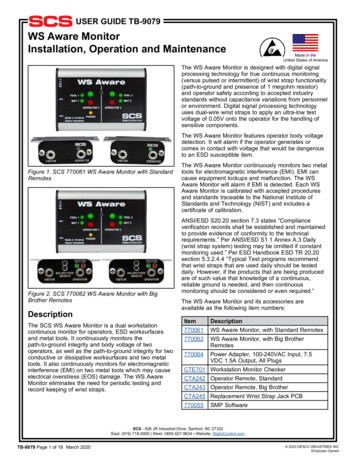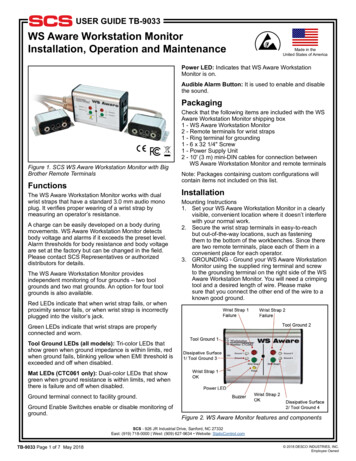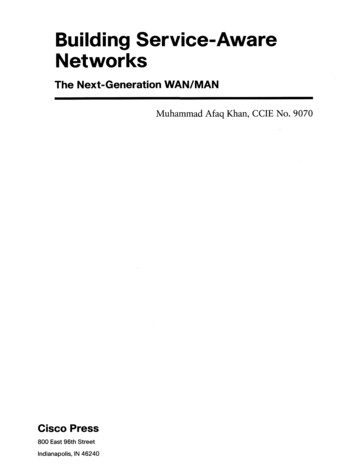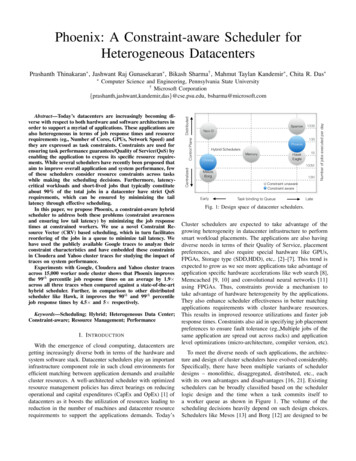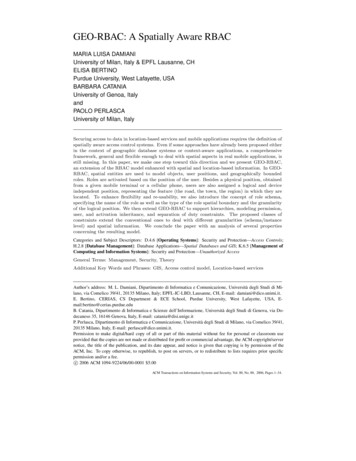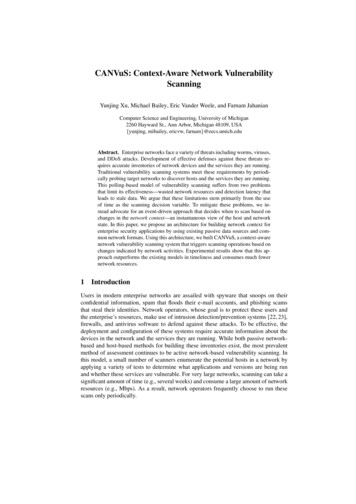
Transcription
CANVuS: Context-Aware Network VulnerabilityScanningYunjing Xu, Michael Bailey, Eric Vander Weele, and Farnam JahanianComputer Science and Engineering, University of Michigan2260 Hayward St., Ann Arbor, Michigan 48109, USA{yunjing, mibailey, ericvw, farnam}@eecs.umich.eduAbstract. Enterprise networks face a variety of threats including worms, viruses,and DDoS attacks. Development of effective defenses against these threats requires accurate inventories of network devices and the services they are running.Traditional vulnerability scanning systems meet these requirements by periodically probing target networks to discover hosts and the services they are running.This polling-based model of vulnerability scanning suffers from two problemsthat limit its effectiveness—wasted network resources and detection latency thatleads to stale data. We argue that these limitations stem primarily from the useof time as the scanning decision variable. To mitigate these problems, we instead advocate for an event-driven approach that decides when to scan based onchanges in the network context—an instantaneous view of the host and networkstate. In this paper, we propose an architecture for building network context forenterprise security applications by using existing passive data sources and common network formats. Using this architecture, we built CANVuS, a context-awarenetwork vulnerability scanning system that triggers scanning operations based onchanges indicated by network activities. Experimental results show that this approach outperforms the existing models in timeliness and consumes much fewernetwork resources.1IntroductionUsers in modern enterprise networks are assailed with spyware that snoops on theirconfidential information, spam that floods their e-mail accounts, and phishing scamsthat steal their identities. Network operators, whose goal is to protect these users andthe enterprise’s resources, make use of intrusion detection/prevention systems [22, 23],firewalls, and antivirus software to defend against these attacks. To be effective, thedeployment and configuration of these systems require accurate information about thedevices in the network and the services they are running. While both passive networkbased and host-based methods for building these inventories exist, the most prevalentmethod of assessment continues to be active network-based vulnerability scanning. Inthis model, a small number of scanners enumerate the potential hosts in a network byapplying a variety of tests to determine what applications and versions are being runand whether these services are vulnerable. For very large networks, scanning can take asignificant amount of time (e.g., several weeks) and consume a large amount of networkresources (e.g., Mbps). As a result, network operators frequently choose to run thesescans only periodically.
2Yunjing Xu, Michael Bailey, Eric Vander Weele, and Farnam JahanianUnfortunately, the dynamics of a hosts’ mobility, availability and service configurations exacerbate the problem of when vulnerability scanning should take place. We define the knowledge of these changes as the context of the network. A context insensitivemodel for vulnerability scanning suffers from wasted resources (e.g., time, bandwidth,etc.) and the observation of stale data. For example, often the network operators who areresponsible for protecting the network do not have full control over the placement andavailability of hosts in the network. Addresses may be allocated to departments withinthe organization who use the addresses in different ways, leaving the network operatorswith little insight into what addresses are allocated or unallocated. Furthermore, thesedepartments themselves often have little control over how their users make use of theseresources and even known, allocated IP addresses and hosts may exhibit availabilitypatterns that are difficult to predict. As a result, network operators spend resources andtime scanning IP addresses that have not been allocated or for hosts that are unavailable.In addition, network operators have limited visibility into what services are beingrun on these hosts because they are typically managed by different administrators. Without the knowledge about the context, the accuracy of detecting these services and theirconfigurations is bound by the frequency of scanning. As a result, any change that occurs since the last scan will obviously not be visible until the next scanning iteration.The rapid occurrence of new, active exploits, announced vulnerabilities, and availablesoftware patches, along with the dynamic nature of how users utilize the network, suggest that even small drifts in these inventories may result in a large security impact forthe organization. Furthermore, the assumption that services remain relatively static overa short period of time is increasingly flawed. The emergence of peer-to-peer, voice-overip, messaging, and entertainment applications have led to a large number of dynamicservices on these hosts. Periodically scanning, by its very nature, only captures a snapshot of those services that are active at an instant in time and it may miss many otherimportant services.To solve these problems, we introduce a context-aware architecture that provides auniform view of network states and their changes. The architecture makes use of existing sources of host behavior across a wide variety of network levels including the link,network, transport, and application layers. Diverse data formats such as syslog, SNMP,and Netflow representing activities at these layers are used to generate abstract viewsthat represent important network activities (e.g., a host connecting to the network, a newsubnet allocated, a new binary in use). Instead of scanning all the hosts in the network atthe same frequency, periodic scanning in our architecture selectively scans hosts basedon their availability patterns. Moreover, these abstract views are used to create eventsabout host configuration changes (e.g., users connecting to a new service, downloadsfrom update sites, and reboots) to trigger active scanning. Thus, this approach is inherently interrupt driven and this event-based model, on top of the context-aware architecture, provides more timely and accurate results. In contrast, scanning periodicallyat a higher frequency would be the alternative, but would require substantially moreresources.To demonstrate the effectiveness of this architecture, a prototype system is constructed and deployed in a large academic network consisting of several thousand active hosts distributed across a /16 and a /17 network. Evaluation of this architecture
CANVuS: Context-Aware Network Vulnerability Scanning3over a 16-day period in March of 2010 illustrates that CANVuS outperforms existingtechniques in detection latency and accuracy with a much fewer number of scans. Theexperimental results also reveal several problems of the current methodology includingthe lack of ground truth and the limited event types, both of which will be addressed infuture work.The rest of this paper is organized as follows: § 2 discusses research papers andcommercial products that relate to enterprise network security, especially vulnerability assessment, and how our system differs from existing solutions. § 3 discusses ouryear-long evaluation of the university’s scanning activities that lead to our current research. § 4 has an in-depth description of our context-aware architecture. Details of theCANVuS system implementation on this architecture is presented in § 5. § 6 describesthe evaluation of CANVuS and the context-aware architecture. § 7 discusses the risksinvolved in this project and our mitigation efforts. The limitations and future work areexplored in § 8. Finally, § 9 concludes the paper.2Related WorkA variety of security software solutions and appliances have been proposed to defendagainst the threats faced by enterprise networks. These fall roughly into those focusedon real-time, reactive detection and prevention and those based on proactive risk identification and policy enforcement. Network-based, real-time detection and preventionsolutions, such as intrusion detection systems [22, 23] are deployed at natural aggregation points in the network to detect or stop attacks buried in network packets by applyingknown signatures for malicious traffic, or by identifying abnormal network behaviors.Host-based antivirus software [18, 32] is meant to protect hosts from being infectedby malicious programs before their binaries are executed and, like network-based approaches, may do so either through static signatures or anomaly detection.In contrast, proactive approaches to network security seek to reason about risks before an attack event happens and to limit exposure to threats. To accomplish this formof proactive assessment and enforcement, these approaches require accurate views ofthe hosts, their locations, and the services running on them. One common way of determining this information is through the use of a network-based vulnerability scanner.Active network-based vulnerability scanners (e.g., Nessus [25], Retina [11]) operateby sending crafted packets to hosts to inventory the targets, providing fingerprints ofthe host operating systems and the host network services. Conversely, passive scanners [8, 17, 26, 31] fingerprint software versions by auditing their network traffic andmatching them with the signature database. They can continuously monitor target networks and are less intrusive to the targets. However, their scope is limited by the trafficthey have access to and, as a result, passive scanners are usually deployed alongside active scanners. In addition to these generic scanners, there has been a great deal of recentwork in specialized scanners that evaluate the security of popular applications such asweb applications [6, 15].Once the accurate inventory and service data is acquired, it can be used for a variety of tasks. For example, firewalls [9] are available to both networks and end hoststo enforce administrator polices, to block unwanted services [1, 2], and to prioritize the
4Yunjing Xu, Michael Bailey, Eric Vander Weele, and Farnam Jahanianpatching of vulnerable services [7, 19] before they are exploited. Often this reasoningmakes use of attack graph representations of this inventory and service data to maketheir placement and configuration services. An attack graph is a graphical representation of all possible ways to compromise hosts in a network by taking advantage ofits vulnerabilities. Sheyner et al. did the early work of attack graph generation using amodel checking approach [27]. Subsequently, several improvements [5, 13, 20, 21] havebeen proposed to solve the scalability problem of the original attack graph approach.Another improvement is the introduction of link analysis methods in attack graphs toautomate the analysis process [16, 24].CANVuS varies from this existing work in that it does not provide new active orpassive tests to determine a host configuration, nor does it propose a new representationor application of the host and service inventory data. Rather, the proposed architecture seeks to provide more up-to-date data with fewer costs than existing approachesby leveraging network context. In this sense, our work is relevant to other work inutilizing context to improve the performance and accuracy of a variety of security techniques [29]. For example, Sinha et al. leveraged the characteristics of the network workload to improve the performance of IDSes [30] and showed that building honeypots thatare consistent with the network could improve the resilience of honeypots to attacks andimprove their visibility [28]. Notions of managing numerous remote probing devicesthrough a middleware layer was explored, though only in the context of IDSes, in theBroccoli system [14]. Cooke et al. built the Dark Oracle [10] that closely resemblesthe work in this paper in terms of methodology by using context-aware information toprovide a database of network state, but it addressed primarily allocation information.Allman et al. proposed a general framework that also uses a trigger-based approachto do reactive network measurement [4]. While this is similar to our work in terms ofthe high-level idea, it tries to solve a different problem, and it contains no implementation or evaluation to demonstrate the effectiveness of their approach. More generally,to address the problems of comprehensive network visibility, a set of guidelines wereoutlined in [3] for three broad categories — basic functionality, handling and storage of data, and crucial capabilities. To our knowledge, no work has fully addressedall of these guidelines, although some work has been attempted to address the storageand querying of this ubiquitous visibility over time and space [34]. Our work makesprogress towards comprehensive network visibility with the goal of creating a flexible,yet efficient unified network visibility system for CANVuS.3MotivationThe motivation for this work derives directly from our interactions with the Universityof Michigan’s office of Information and Infrastructure Assurance (IIA) [33]. This groupis tasked with: “(i) Facilitating campus-wide incident response activities, (ii) Providingservices such as security assessments and consultation, network scans, education andtraining, and (iii) Managing IT security issues at the university level.” As part of theseroles, this office engages in quarterly scans of seven /16 subnets belonging to the University of Michigan. As part of an effort to evaluate this process, we assisted the IIAstaff in analyzing several quarterly scans of this space by using both Nessus [25] and
CANVuS: Context-Aware Network Vulnerability Scanning5Retina [11]. The results of this analysis were kept private to assist the security operationstaff, but we were struck by several poignant observations from the experience:– The scans generally take one and a half to two weeks to complete.– In an effort to reduce the amount of time spent scanning, a significant number ofvulnerability signatures present in the tools were not used.– With the exception of a handful of departments, the scans of the IP space proceededwithout knowledge of sub allocations in each department, scanning large blocks ofspace in their entirety.– Due to the impact of work day availability patterns, the operators schedule the scansto occur only during working hours (i.e., 8 AM to 5 PM, Monday through Friday).– Only 85% of the IP addresses in each scan were shared, the other 15% were unique.– Only 85% of the total unique vulnerabilities discovered were present in both scans,with 15% of each scan’s vulnerabilities appearing only in that scan.– Only 56% of the configurations between two scans were unchanged for those IPsin common between the scans.While surprising to us, the IIA staff were keenly aware of the dynamic nature of theirnetwork and the overhead imposed by the scanning activities. Although they deployedseveral stop-gap measures to deal with the effect of this dynamic network context (e.g.,scan during work hours), these operators simply lacked the platform with which toachieve network-wide visibility.4Architecture and DesignIn this section, we describe a context-aware architecture that provides a uniform viewof network states and their changes for security applications. The architecture consistsof three major components. The first component is a set of network monitors that aredistributed over many network devices. The list of network devices to monitor couldinclude switches, routers, and servers, but the architecture allows for other similar devices as well. The second major architectural component is a Context Manager, whichconverts data from network monitors to a network state database. The third and finalcomponent is the network state database that provides a uniform model for contextaware vulnerability scanning. Other context-aware applications may be built upon thisdatabase as well. A high-level diagram with the major components of the architectureis illustrated in Figure 1.The design of this context-aware architecture is informed strongly by the designprinciples outlined in Allman et al. [3], especially those basic guidelines of scope, incremental deployability, and operational realities. We aim for a system that built foran individual enterprise and utilizes existing sources of data collected from infrastructure and services already deployed in the network. We utilize the existing common data formats (e.g., syslog, SNMP, Netflow) and store and access this data throughcommon, extensible mechanisms (e.g., databases, SQL). Where necessary, we supportprobe-based mechanisms for extracting similar data from network data streams in theevent that existing hardware is overloaded or does not support data export. With respect to the outlined data-oriented goals, we opt to focus on exploring data breadth over
6Yunjing Xu, Michael Bailey, Eric Vander Weele, and Farnam JahanianActiveScanningKerberos ServerSyslogNetworkProbesBroNetwork State DatabaseSyslogNetworkServicesDNS ServerDHCP ServerTriggerContext Management MiddlewareSNMPAccess sSwitchesScanningSubsystemVuln.DBCANVuS: Context-AwareNetwork VulnerabilityScanningOther Context AwareApplicationsContext Aware ArchitectureFig. 1. Our context-aware network vulnerability scanning (CANVuS) architecture. The enterprisenetwork is monitored by using data from existing physical infrastructure devices, network serviceappliances, and generic network probes. These heterogeneous sources of data are combined intoa unified view of the network context which can be queried by context-aware applications orcan have triggers automatically executed in response to certain contextual changes. In the caseof CANVuS, contextual changes that indicate possible configuration changes are used to moreefficiently scan network devices.long term storage, smart storage management, graceful degradation, etc. The CANVuSapplication does not require extensive historical data, although we acknowledge thatother context-aware applications will indeed require these functionalities and we lookto leverage existing work in this direction for future versions of our architecture [34].In the next three subsections, we first describe categories of monitoring points ordata sources, from which creates a view of network context. Using this understanding,we then present the design of the Context Manager, which converts data from networkmonitors to the network state database in a uniform representation. Finally, we provide an example of what the network state database would look like for context-awareapplications.4.1Sources of DataInferring network states and state changes is a challenging problem because the required information is distributed across many devices, network services, and applications. Thus, the key to capture the states and changes is to monitor the targets from anetwork perspective and approximate the context by aggregating network events fromvarious data sources, which may lay in different layers of the network stack. To determine what data sources to use for event collection and integration, we first need tounderstand what types of network activities could be monitored and how they relate tochanges in the network.In this architecture, the monitors distributed across the network fall into three categories. The first category is monitors deployed in infrastructure devices, such as switches,
CANVuS: Context-Aware Network Vulnerability Scanning7routers and wireless access points. The advantage of having these types of monitors isthat they provide detailed knowledge about the entire network, as well as the host information, with high resolution. This is a direct result of these devices providing the corehardware infrastructure for the network. For example, by querying the switche
termining this information is through the use of a network-based vulnerability scanner. Active network-based vulnerability scanners (e.g., Nessus [25], Retina [11]) operate by sending crafted packets to hosts to inventory the targets, providing fingerprints of the host operating systems
